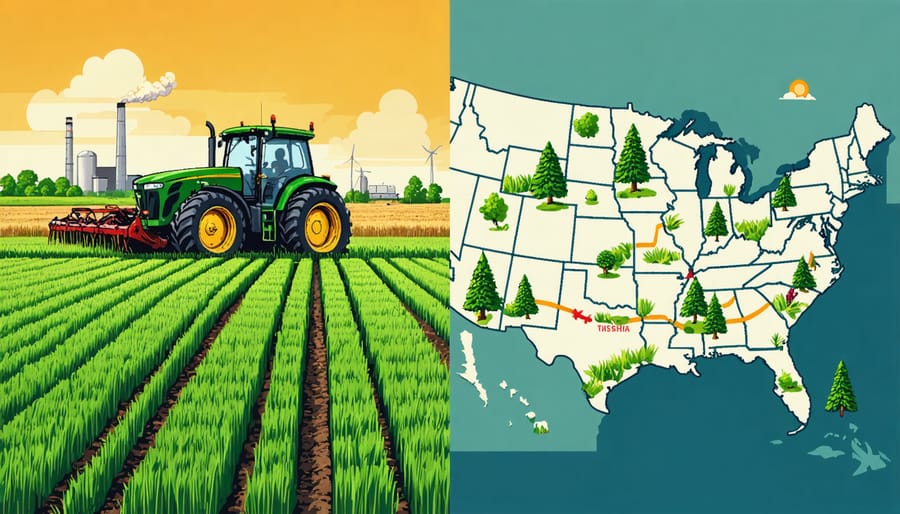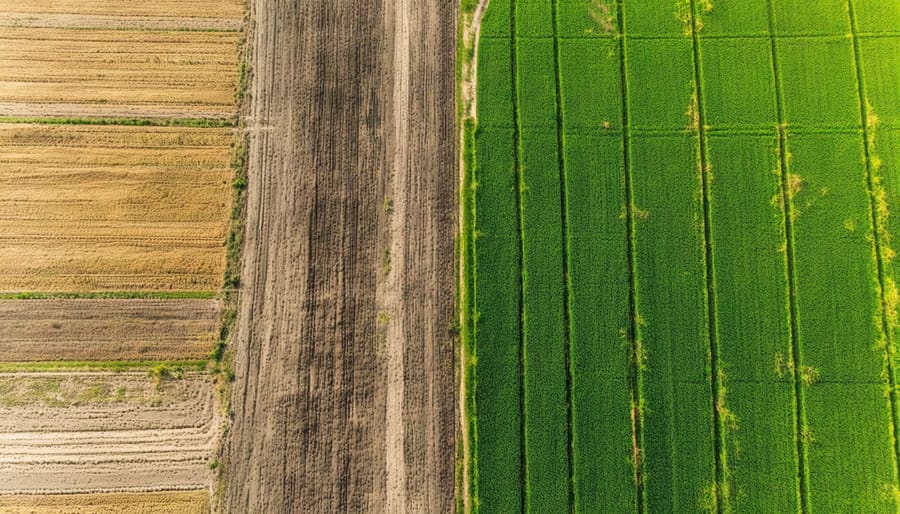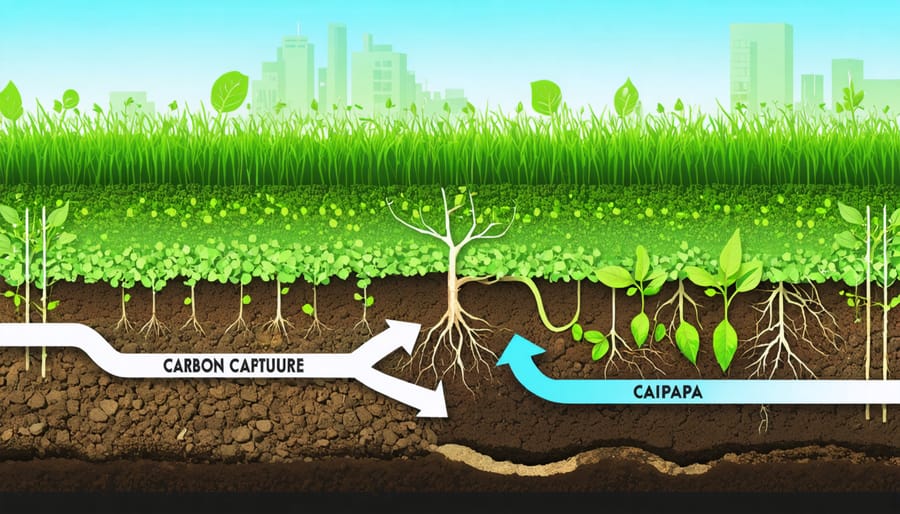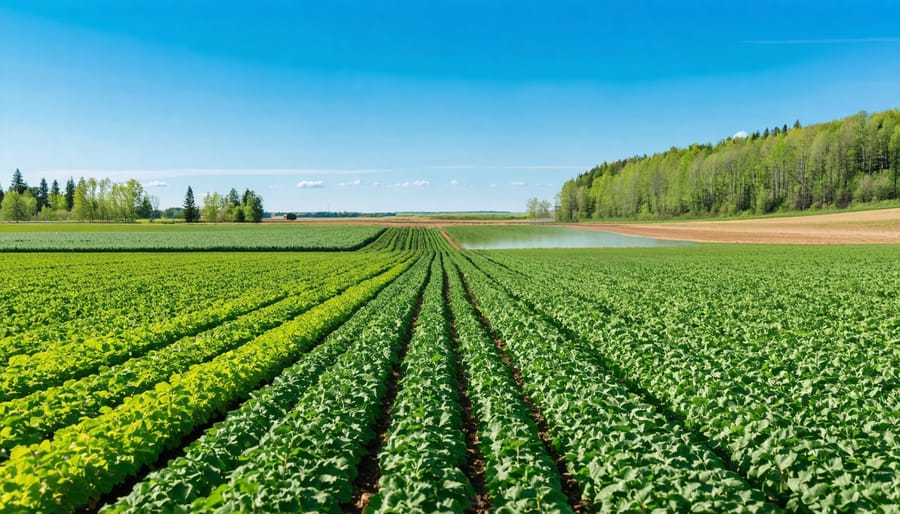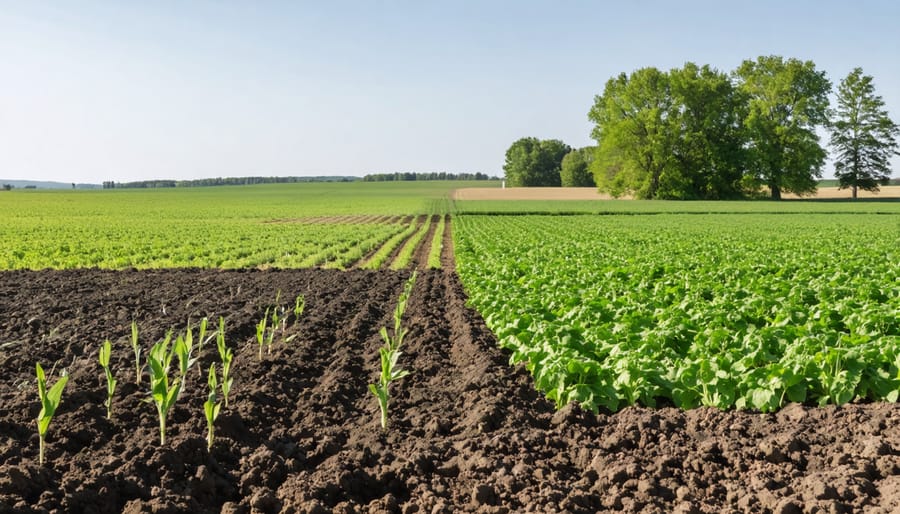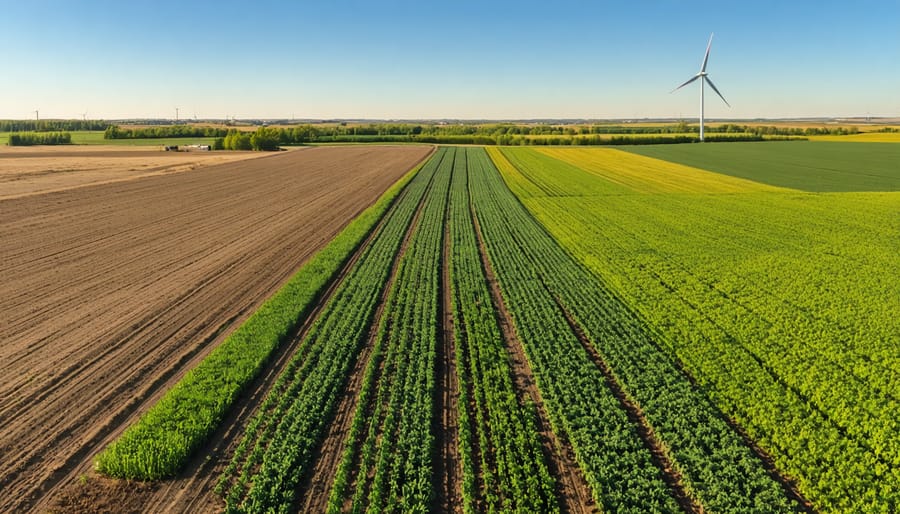Understanding U.S. carbon emissions by sector reveals critical opportunities for Canadian farmers to enhance their competitive advantage in a rapidly evolving agricultural market. As Alberta’s agricultural sector navigates carbon pricing and environmental regulations, American emission patterns directly influence cross-border trade dynamics and market access. Transportation and electricity generation remain the largest emission sources in the U.S., accounting for 27% and 25% respectively, while agriculture contributes 11% – creating strategic openings for Canadian producers who demonstrate lower carbon footprints.
For Alberta farmers, this data translates into tangible economic opportunities. Our province’s leadership in sustainable farming practices, including precision agriculture and carbon sequestration, positions local producers to capture premium prices in U.S. markets increasingly focused on environmental impact. Recent studies show that Canadian agricultural products with verified lower emissions command up to 15% higher prices in certain U.S. market segments.
By understanding these sector-specific emission patterns, Alberta’s agricultural community can strategically invest in emission-reducing technologies and practices that align with U.S. market demands, while simultaneously building resilience against future carbon-related trade measures. This knowledge directly impacts farm-level decision-making, from equipment upgrades to crop selection and soil management strategies.
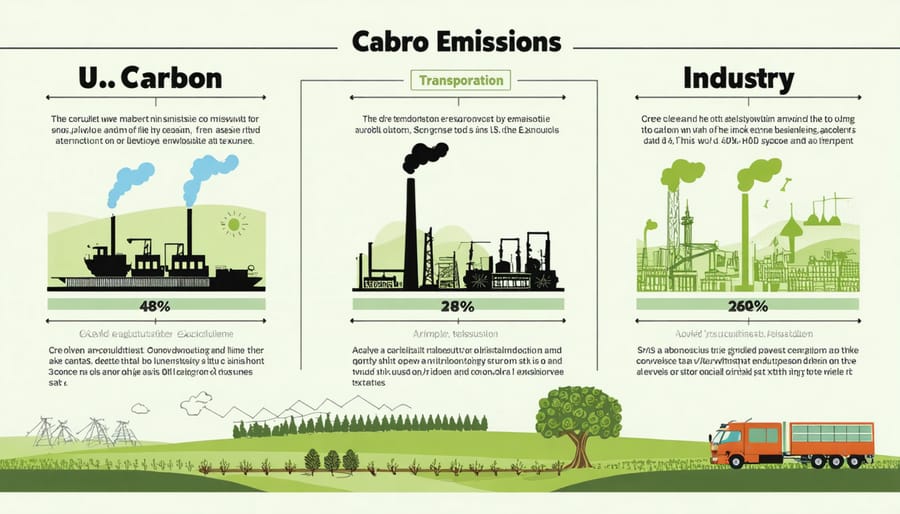
Understanding U.S. Carbon Emission Sectors
Transportation and Industrial Impact
Transportation and industrial emissions from the U.S. significantly influence cross-border agricultural trade, creating both challenges and opportunities for Canadian farmers. Recent data shows that U.S. transportation emissions, particularly from heavy-duty trucks carrying agricultural products, account for approximately 27% of total U.S. carbon emissions, while industrial processes contribute another 23%.
For Alberta farmers, these emissions directly impact operational costs through carbon pricing mechanisms and border adjustment measures. However, this also presents opportunities for those implementing sustainable practices. Farmers using low-emission equipment or participating in carbon offset programs often receive preferential treatment in cross-border trade agreements.
Rob Anderson, a fourth-generation farmer from Lethbridge, shares, “We’ve seen a 15% reduction in shipping costs by partnering with carbon-conscious transportation companies and optimizing our delivery routes.” This approach has helped maintain competitive pricing while meeting increasingly strict environmental standards.
The industrial sector’s emissions also affect agricultural input costs, particularly for fertilizers and farm equipment manufactured in the U.S. Many Alberta farmers are responding by forming cooperatives to bulk-purchase from manufacturers with lower carbon footprints, resulting in both environmental and economic benefits.
Looking ahead, experts predict that farms demonstrating lower transportation and processing emissions will likely secure better trade terms and market access, making early adoption of sustainable practices a strategic advantage for Canadian agricultural operations.
Agricultural Sector Emissions
The agricultural sector in the United States contributes approximately 10% of total carbon emissions, primarily through livestock management, soil cultivation, and fuel consumption. When compared to Canadian operations, particularly in Alberta, U.S. farms typically emit 15-20% more greenhouse gases per hectare due to different farming intensities and management approaches.
However, innovative carbon farming practices being implemented across Alberta demonstrate how emission reductions can be achieved while maintaining productivity. For instance, the adoption of no-till farming in Southern Alberta has reduced fuel consumption by up to 40% while improving soil carbon sequestration by 0.2-0.3 tonnes per hectare annually.
Recent data shows U.S. agricultural emissions increasing by 1.3% annually, while Canadian farms implementing regenerative practices have managed to decrease their emissions by 0.8% year-over-year. This difference presents an opportunity for Canadian farmers to maintain their competitive advantage through continued adoption of sustainable practices.
Key emission sources in both countries include methane from livestock (40%), nitrous oxide from fertilizer application (30%), and carbon dioxide from equipment operation (20%). The remaining 10% comes from various on-farm activities including crop residue burning and manure management. Understanding these breakdowns helps farmers identify where the most significant improvements can be made while maintaining operational efficiency.
Economic Opportunities in Carbon Data Transparency

Carbon Credit Markets
As U.S. carbon emissions data continues to shape North American climate policies, Canadian farmers are discovering valuable opportunities in emerging soil carbon markets. Alberta’s carbon offset system has been particularly successful, offering farmers a chance to generate additional revenue while contributing to emission reduction goals.
For example, the Alberta Conservation Cropping Protocol has enabled farmers to earn carbon credits through practices like no-till farming and improved crop rotations. Local farmer Jim Anderson from Red Deer County reports earning an additional $15 per hectare annually through carbon credit sales while improving his soil health.
These market opportunities are expanding beyond traditional offset programs. Several private companies now offer carbon credit contracts directly to farmers, with payments ranging from $15 to $40 per tonne of carbon sequestered. These programs typically require a 5-to-10-year commitment and focus on practices such as cover cropping, reduced tillage, and precision nutrient management.
To participate effectively, farmers should:
– Document current land management practices
– Establish baseline soil carbon measurements
– Implement verified carbon-sequestering practices
– Maintain detailed records of farming activities
– Work with approved verification bodies
The Carbon Offset Protocol in Alberta has already generated over $500 million in carbon credit value since its inception, with agricultural projects playing a significant role. As U.S. emission reduction targets influence North American markets, experts predict growing demand for agricultural carbon credits, potentially doubling current values within the next five years.
Local agricultural extension services and carbon program aggregators can help farmers navigate these opportunities, ensuring compliance while maximizing financial benefits. Many successful participants recommend starting with a small portion of land to learn the system before expanding their carbon credit program farm-wide.
Soil Health Investment Returns
Investing in soil health through carbon management practices isn’t just good for the environment – it’s becoming increasingly profitable for farmers across Alberta. Recent studies show that implementing soil carbon enhancement practices can yield returns ranging from $30 to $80 per hectare annually through improved crop yields and reduced input costs.
Local farmer Jim Robertson from Leduc County reports a 15% increase in wheat yields after three years of implementing cover cropping and reduced tillage practices. “The initial investment was about $45 per hectare, but we’re seeing returns through better moisture retention and reduced fertilizer needs,” Robertson explains.
Carbon offset markets are creating additional revenue streams for farmers who adopt these practices. Through Alberta’s carbon offset system, farmers can earn credits worth $30-45 per tonne of carbon sequestered. A typical 400-hectare farm implementing comprehensive soil health practices can sequester 1-2 tonnes of carbon per hectare annually, potentially generating $12,000-36,000 in additional annual revenue.
Beyond direct financial returns, improved soil health delivers long-term benefits including:
– Reduced erosion and improved drought resilience
– Lower fertilizer and pesticide costs
– Better water infiltration and retention
– Increased organic matter content
– Enhanced biodiversity and soil microbiome health
The Agricultural Research and Extension Council of Alberta estimates that every 1% increase in organic matter can increase water holding capacity by approximately 144,000 litres per hectare. For drought-prone regions, this water retention improvement alone can justify the investment in soil health practices.
Local agricultural extension services offer free soil health assessments and can help farmers develop customized implementation plans that maximize both environmental and economic benefits. With carbon markets expanding and climate variability increasing, investing in soil health represents a smart business decision for forward-thinking Alberta farmers.
Practical Implementation for Alberta Farmers
Data Collection Methods
Data collection in U.S. carbon emissions tracking involves a comprehensive network of monitoring stations, satellite technology, and ground-level measurements across different sectors. For agricultural regions, soil carbon monitoring techniques have evolved significantly, now incorporating both traditional soil sampling and advanced digital sensing technologies.
Farmers in Alberta will find familiar methods being used, such as direct soil sampling at various depths, which provides baseline data for carbon content analysis. These samples are typically collected seasonally and analyzed in certified laboratories using standardized protocols. Modern approaches also include the use of remote sensing technology, which helps track changes in soil organic matter across large agricultural areas.
The Environmental Protection Agency (EPA) coordinates with various agricultural institutions to gather data through a network of flux towers. These towers measure the exchange of carbon dioxide between the soil and atmosphere, providing real-time data that helps understand carbon sequestration patterns in different farming systems.
Mobile soil testing units are increasingly common, allowing for rapid on-site analysis and immediate feedback to farmers. This approach has proven particularly valuable for Alberta farmers participating in carbon credit programs, as it provides quick verification of soil carbon levels.
Importantly, many Canadian farmers are already familiar with these monitoring methods through participation in provincial carbon offset programs. The consistency between U.S. and Canadian measurement protocols makes it easier for Alberta farmers to understand and implement similar practices on their own land, potentially opening doors for cross-border carbon market opportunities.
Regular reporting involves documenting farming practices, including tillage methods, crop rotations, and organic matter additions. This data helps create a comprehensive picture of how agricultural practices influence carbon emissions and sequestration rates, supporting both environmental goals and potential economic benefits for farmers.
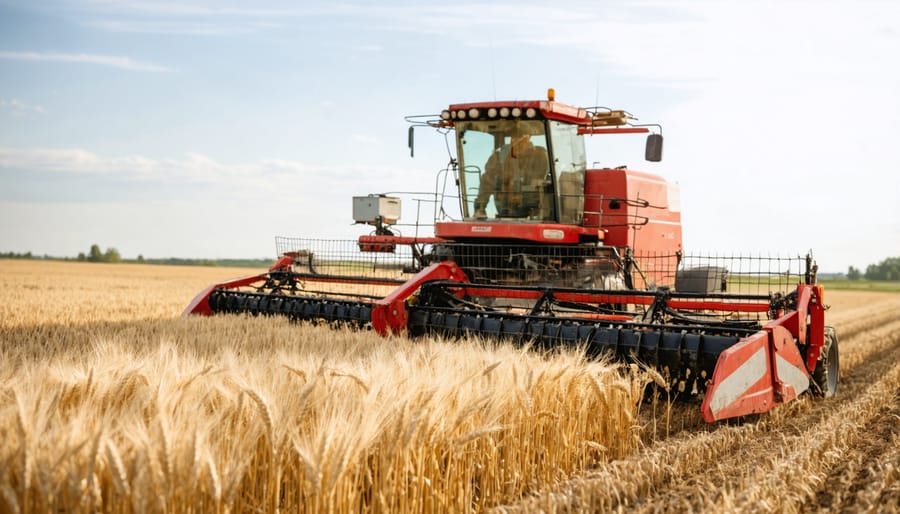
Market Integration Strategies
Connecting with carbon markets offers Canadian farmers significant opportunities to benefit from their emission reduction efforts. The key is understanding how to effectively integrate these markets into your existing agricultural operations. Many Alberta farmers have already successfully tapped into these markets, creating additional revenue streams while contributing to environmental sustainability.
Start by conducting a thorough baseline assessment of your farm’s current emissions. This initial step helps identify areas where you can make meaningful reductions and quantify potential carbon credits. Local agricultural extension offices and carbon market advisors can assist with this process, often providing free or low-cost evaluation services.
Working with aggregators has proven successful for many Alberta farmers. These organizations help bundle carbon credits from multiple farms, making it easier to access larger markets and secure better prices. The Alberta Carbon Offset System, for example, has helped numerous local farmers monetize their sustainable practices through aggregator partnerships.
Consider implementing verified carbon protocols that align with your existing operations. Popular options include no-till farming, precision nutrient management, and rotational grazing. These practices not only generate carbon credits but often improve soil health and crop yields, creating multiple benefits for your operation.
Documentation is crucial for market participation. Maintain detailed records of your farming practices, including field operations, input applications, and yield data. Modern farm management software can streamline this process, making it easier to verify your carbon credit claims.
Network with other farmers who are already participating in carbon markets. Many agricultural associations in Alberta host regular workshops and peer-learning sessions where you can gain practical insights from experienced participants. These connections often lead to valuable partnerships and shared learning opportunities.
Remember to start small and scale up gradually. Focus initially on implementing one or two carbon credit-generating practices, perfect your approach, and then expand as you become more comfortable with the market mechanisms. This measured approach helps minimize risk while maximizing long-term benefits.
As we’ve explored the U.S. carbon emissions landscape, it’s clear that Alberta farmers are uniquely positioned to lead in sustainable agriculture while building more resilient operations. The opportunities ahead are both environmentally and economically promising, with carbon offset markets offering new revenue streams for those who adopt emission-reducing practices.
The path forward involves implementing proven strategies like reduced tillage, cover cropping, and improved grazing management. These practices not only cut emissions but also enhance soil health and productivity. Many Alberta farmers are already seeing success with these methods, demonstrating that environmental stewardship and profitable farming can go hand in hand.
To get started, consider connecting with local agricultural extension services and joining farmer-led initiatives that share knowledge and resources. Taking advantage of available carbon credit programs and government incentives can help offset the initial costs of transitioning to low-emission practices.
Remember, every step counts. Whether you’re just beginning to explore emission reduction strategies or looking to expand existing efforts, there’s support available within our farming community. By working together and sharing our experiences, Alberta farmers can build a more sustainable future while maintaining our position as agricultural leaders.
The time to act is now. With growing market demands for sustainable products and increasing carbon pricing implications, early adopters will be best positioned to thrive in tomorrow’s agricultural landscape. Let’s embrace these opportunities and continue our proud tradition of innovation in Alberta farming.

